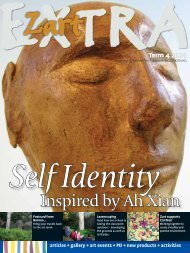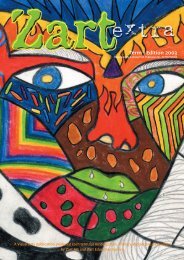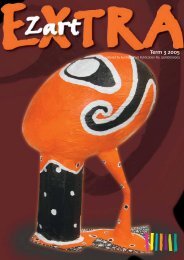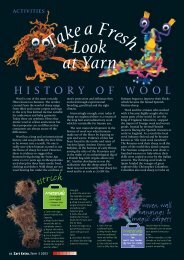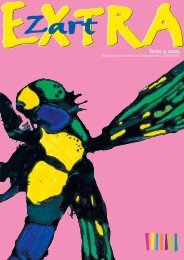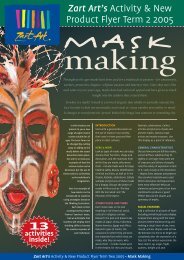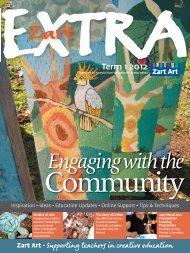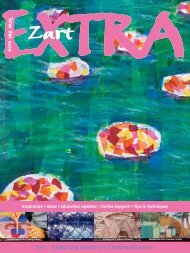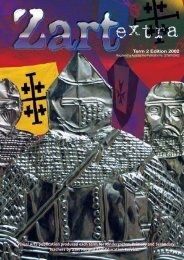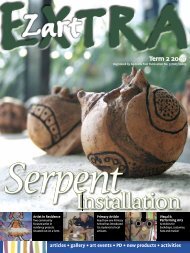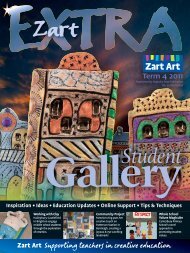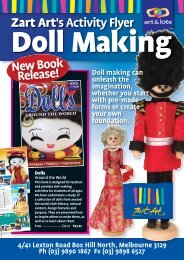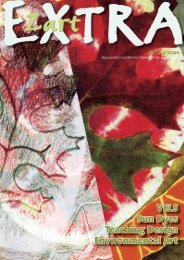Term 2 2004 - Zart Art
Term 2 2004 - Zart Art
Term 2 2004 - Zart Art
- No tags were found...
Create successful ePaper yourself
Turn your PDF publications into a flip-book with our unique Google optimized e-Paper software.
<strong>Term</strong> 2 <strong>2004</strong><br />
Registered by Australia Post Publication No. 327687/00003
contents<br />
cover +<br />
page 3<br />
Primary <strong>Art</strong>icle:<br />
Dragons<br />
Montrose Primary<br />
School Montrose<br />
page 4<br />
Secondary <strong>Art</strong>icle:<br />
Religious Inspiration<br />
Thomas Carr College<br />
Hoppers Crossing<br />
page 6<br />
Claymation<br />
Discover the complexity of<br />
clay animation with John<br />
Cordon.<br />
page 7<br />
<strong>Zart</strong>’s Student Gallery<br />
What’s on and featuring in<br />
our Gallery for <strong>Term</strong> 2<br />
<strong>2004</strong>.<br />
page 8<br />
Profile:<br />
Knitting in school Hours<br />
Kalinda Primary School<br />
knits for a good cause.<br />
page 9<br />
New<br />
Products<br />
& ideas<br />
page 10<br />
Activity: Calico bags<br />
Decorate your own Calico<br />
Bags!<br />
page 12<br />
New<br />
Resources<br />
The Visual Thinking Curriculum<br />
ZART EXTRA<br />
A Visual <strong>Art</strong>s<br />
publication<br />
produced each<br />
term for<br />
Pre-school,<br />
Primary &<br />
Secondary<br />
Teachers by<br />
<strong>Zart</strong> <strong>Art</strong> and<br />
<strong>Zart</strong> Education<br />
Service.<br />
The good teacher instructs,<br />
the excellent teacher invites,<br />
the superior teacher involves,<br />
the great teacher inspires.<br />
Currently in education, there is a<br />
worldwide explosion of interest in<br />
thinking. It seems to come at a time when<br />
we are trying to take stock of the rapid<br />
technological advancements that have<br />
changed the types of jobs we perform and<br />
how we perform them. The idea that<br />
students can improve their competence by<br />
learning how to think more effectively is<br />
paving the way for educational change. It<br />
seems our society has realized that<br />
machines are doing much of the function<br />
and routine thinking previously done by<br />
humans. In an attempt to preserve human<br />
dignity and utilize our unique human<br />
characteristics, we are focusing on an area<br />
which machines, so far, haven’t mastered:<br />
that of high-order thinking, be it, for<br />
example, analytical, divergent or creative<br />
thinking.<br />
The old view that thinking depends on<br />
a person’s inborn ability has been<br />
dismissed by many well-respected<br />
researchers who argue that thinking is a<br />
learned process and should not be left to<br />
chance. Using the building blocks of<br />
experience, some people are quicker than<br />
others in acquiring skills and strategies in<br />
thinking - study skills are one example of<br />
this - but for most of us it is appropriate<br />
teaching skills that will help raise our<br />
awareness and teach us new strategies to<br />
improve our level of competence. Dr <strong>Art</strong><br />
Costa, an American at the forefront of<br />
research in creative thinking, claims, “It<br />
takes skill and practice to think creatively<br />
Robin Fogarty : Chicago, 1999<br />
and thoughtfully” and “You don’t teach<br />
students to think in just one lesson or one<br />
year”.*<br />
A call for The Thinking Curriculum<br />
challenges us to revise current pedagogy<br />
and look at teacher quality and the type of<br />
classroom climate conducive to thinking.<br />
Most schools are opting to change<br />
their approach to teaching by making the<br />
steps of thinking more explicit, rather<br />
than treating it like an add-on subject. In<br />
this quest to educate better thinkers, there<br />
are some fundamental questions that are<br />
being addressed, such as: How is thinking<br />
actually taught How much time should<br />
be spent on the process (of thinking) as<br />
opposed to content Are there methods,<br />
techniques and strategies that can be<br />
transferred from one discipline to<br />
another, and from the classroom to the<br />
real world<br />
Without doubt, classrooms with high<br />
quality teachers and a climate where<br />
students are not afraid to take risks are<br />
the ones that will empower students to<br />
develop broader thinking capabilities. As<br />
for creative thinking methodology, is it a<br />
well-kept secret that the art room has long<br />
been a place where creative thinking has<br />
flourished Although the practice of<br />
teaching uncreative thinking does exist in<br />
some art rooms, for the most part art<br />
teachers have a genuine interest in<br />
engaging students in creative thinking. In<br />
one art lesson a teacher might ask<br />
students to set their own questions to stimulate<br />
critical and analytical thinking in response to<br />
specific art works. Then the hands-on path to<br />
enrichment and creativity might challenge<br />
students to think divergently about a specific<br />
tool or medium to discover its properties. Once<br />
these discoveries have been made, students<br />
might indulge in risks and develop independent<br />
thinking to create their own art works. This<br />
range of thinking skills could well be adopted by<br />
other disciplines, especially those that are more<br />
content driven. All this high level thinking will<br />
prepare students to operate more effectively in<br />
our changing society. After all, life is a lifelong<br />
adventure in learning and learning requires<br />
thinking.<br />
<strong>Zart</strong> Education Service<br />
*Engaging the Brain - article by Dr <strong>Art</strong> Costa<br />
Teachers Make the Difference by Robin Fogarty,<br />
Hawker Brownlow Education, 2001.<br />
More Ways Than One - Fostering Creativity by<br />
<strong>Art</strong>hur J. Cropley, ablex Corp., 1992.<br />
The Thinking Curriculum by John Nisbet, from<br />
Research in Education no. 47 Autumn, 1990.<br />
<strong>Zart</strong> <strong>Art</strong> <strong>Term</strong> Two : This will be an<br />
eventful term as we get set for the <strong>2004</strong><br />
Athens Olympic Games, as well as<br />
venturing through creative doorways in<br />
Book Week <strong>2004</strong>! To help celebrate, Zes &<br />
<strong>Zart</strong> have released two great new books<br />
(see page 9) & have organised many fresh &<br />
creative workshops that will spill over<br />
into term 3. Please refer to your term 2<br />
workshop insert or our website for upto-date<br />
workshop details :<br />
www.zartart.com.au/Workshopsmain.htm<br />
Topping off the term is our annual <strong>Zart</strong><br />
<strong>Art</strong> Expo & Clearance Sale on july 9th, <strong>2004</strong>.<br />
Arrive early & pick up a bargain or take<br />
part in one of our FREE product<br />
demonstrations! (see page 9 for more info)<br />
<strong>Zart</strong> <strong>Art</strong> School &<br />
Wholesale Supplier<br />
<strong>Zart</strong> <strong>Art</strong> offers an extensive<br />
range of resources, art<br />
materials, craft and<br />
technology supplies. You<br />
will find competitive prices<br />
and efficient and quick<br />
service.<br />
5/41 Lexton Road<br />
Box Hill North Vic 3129<br />
Ph: (03) 9890 1867<br />
Fax: (03) 9898 6527<br />
www.zartart.com.au<br />
zartart@zartart.com.au<br />
Hours:<br />
Mon-Fri: 8.30am-5.00pm<br />
Sat: 8.30am-12.00 noon<br />
<strong>Zart</strong>’s Student Gallery<br />
The gallery features art<br />
works made by students of<br />
Prep to Year 12 from all<br />
around Victoria. Schools<br />
can arrange for students to<br />
visit the gallery, analyse<br />
the works of their<br />
contemporaries and then<br />
make a relevant piece of<br />
their own art work in our<br />
workshops with an art<br />
consultant. The gallery is<br />
also open to the public for<br />
viewing during opening<br />
hours (please see <strong>Zart</strong><br />
hours) free of charge.<br />
For <strong>Term</strong> Gallery listings<br />
refer to our <strong>Zart</strong> Extra and<br />
our website.<br />
<strong>Zart</strong> Education Service<br />
<strong>Zart</strong> Education Service<br />
provides hands on<br />
professional development<br />
workshops for primary and<br />
secondary teachers, as well<br />
as LOTE teachers, Preschools,<br />
and librarians.<br />
Visual <strong>Art</strong>s workshops are<br />
regularly held at <strong>Zart</strong> and in<br />
metropolitan and country<br />
locations and upon request<br />
at your school, district or<br />
KLA’s group.<br />
Please refer to the ‘Workshop<br />
Insert’, a supplement to every<br />
<strong>Zart</strong> Extra or refer to our<br />
website for dates and times.<br />
<strong>Zart</strong>works (Retail Shop)<br />
<strong>Zart</strong>works have all your art<br />
and craft needs catering for<br />
both beginner and<br />
professional artists. You can<br />
select from a wide range of<br />
visual arts, craft and graphic<br />
supplies. Browse at your<br />
leisure or seek assistance<br />
from our experienced staff.<br />
3/41 Lexton Road<br />
Box Hill North Vic 3129<br />
Ph: (03) 9890 5110<br />
Fax: (03) 9898 6527<br />
Internet:<br />
zartart@zartart.com.au<br />
email:<br />
zartworks@zartart.com.au<br />
Hours:<br />
Mon-Fri: 9.00am-5.00pm<br />
Sat: 9.00am-12.00 noon<br />
2 <strong>Zart</strong> Extra_<strong>Term</strong> 2 <strong>2004</strong>
primary article<br />
A DALLIANCE WITH DRAGONS<br />
The idea of this unit was to combine the<br />
development of drawing and design<br />
skills with an appreciation of art in<br />
other cultures, particularly in Asia and<br />
Japan. I collected an array of painted<br />
artefacts such as silk fans, umbrellas,<br />
scarves and wall hangings as a motivator<br />
for discussion. We also discussed design,<br />
proportions, pattern, line and colour.<br />
Task One<br />
The students were excited by the idea of<br />
drawing onto a Paper Screen. The theme of<br />
‘Dragons’ was chosen because of the strong<br />
association with Asia and because it is a<br />
dramatic subject that captured the<br />
imagination of the students.<br />
Their first task was to sketch their design on<br />
to paper of the same space as the screen. I<br />
used Kate Hart’s Drawing Dragons (Dragons<br />
- <strong>Zart</strong> <strong>Art</strong> Pub. 1993) to stimulate ideas for<br />
possible images that the students could<br />
create. We discussed the layout of the piece<br />
and position and attitude of the dragon on<br />
the screen, eg. Will your creature be flying<br />
up the screen or down the screen and,<br />
importantly, will your design fill the space<br />
Task Two<br />
During this lesson I demonstrated sketching<br />
a dragon and we talked about shape, line<br />
and pattern.<br />
Students completed their sketches and<br />
outlined them in black felt pen. They were<br />
then able to trace their drawings on to the<br />
Paper Screens.<br />
Task Three<br />
We used Ocaldo Blocks to paint the dragons.<br />
During this session we discussed<br />
contrasting colours, backgrounds and<br />
patterns. A large selection of wonderful<br />
coloured and printed papers were also<br />
provided to enhance their work, and let’s<br />
not forget a liberal splatter of Glitter,<br />
Sequins and Gold and Silver Pens.<br />
Conclusion<br />
The students’ work will be displayed in all<br />
its glory at our Autumn Fair <strong>Art</strong> Show so<br />
that proud parents and the school<br />
community can enjoy the wonderful work<br />
our Year 6 artists have produced.<br />
Mary Cooper<br />
Montrose Primary School<br />
<strong>Zart</strong> Extra_<strong>Term</strong> 2 <strong>2004</strong> 3
4 <strong>Zart</strong> Extra_<strong>Term</strong> 2 <strong>2004</strong>
secondary article<br />
Religious Inspiration<br />
Thomas Carr College<br />
Most people would define a<br />
church or a temple as a house<br />
of God where worshippers<br />
come to pray. For me my<br />
church and my religion were<br />
my inspiration for my Year 12<br />
art folio. Church interiors are<br />
greatly defined by their unique<br />
carved decorative features and<br />
their statues, which have<br />
dominant stance and<br />
definitive designs. I sat in<br />
church one day and was<br />
captivated by what was<br />
around me, and I wondered<br />
how such beautiful pieces<br />
were created. As I sat there, it<br />
occurred to me that I was<br />
really sitting in a religious art<br />
museum.<br />
The theme for my art folio<br />
was ‘that which is categorised<br />
as either religious art or gothic<br />
art’. In order to incorporate my<br />
religion into my art work<br />
concept, I began to research<br />
what Catholicism was about<br />
and why it drew so many<br />
worshippers to believe in this<br />
faith. Many biblical scriptures,<br />
fonts, references, images and<br />
miracle sightings were<br />
researched as I wanted to<br />
thoroughly review the basis of<br />
my art works concept of<br />
designs.<br />
While I tested many media<br />
and created each piece of art<br />
work, I kept the words<br />
simplicity, antique, religious<br />
and ancient in mind. The three<br />
large panels were constructed<br />
out of a range of media, which<br />
were combined to create the<br />
collaged look. Papers ranging<br />
from all styles of texture yet<br />
limited to a theme of colours<br />
such as black, white, cream,<br />
gold and bronze were then cut<br />
into squares and rectangles<br />
and used for the collage.<br />
Certain sections of the<br />
panels contained biblical<br />
stories that were printed on<br />
tracing paper, while other<br />
panels were created from<br />
scratch by applying spray<br />
paint, acrylic paint and poster<br />
paint to many different<br />
stylised papers. Another form<br />
of mixed media that was used<br />
was black silk material that<br />
was cut and placed on the<br />
collage to create a unique and<br />
individual look to a particular<br />
section. Layers upon layers of<br />
materials were placed on top<br />
of each other while I worked<br />
on the foreground, scale,<br />
balance, shape, colour and<br />
texture of each panel.<br />
The art works combine<br />
visual communication design<br />
techniques that I learnt<br />
through my art and my<br />
knowledge of materials, which<br />
I had gained through my study<br />
of textiles; these were the<br />
main subjects I studied in my<br />
VCE years. However, it wasn’t<br />
until Mrs Daniella Franze - my<br />
very enthusiastic and<br />
dedicated art teacher, whose<br />
passion for art is an cont.<br />
!<br />
LEFT: The developmental process. Snapshots<br />
from Alloyesha’s Visual / process diaries.<br />
<strong>Zart</strong> Extra_<strong>Term</strong> 2 <strong>2004</strong> 5
secondary article cont<br />
inspiration to many - suggested that I<br />
apply Shellac glaze, that these pieces<br />
turned into sacred- looking treasures of<br />
the biblical and ancient world. Many<br />
smaller works were also created as I tried<br />
to revolutionise Catholic art of the past to<br />
form modern contemporary pieces. The<br />
use of scripture and typography designs<br />
were also incorporated throughout my<br />
folios and art works.<br />
Overall, the art pieces were created<br />
from a religious point of view with the<br />
aim of challenging individuals viewing<br />
the art work to look at their own faith<br />
response. As a Catholic, I see my religion<br />
represented and compressed into a<br />
collaged mixed media construction. The<br />
whole outlook is portrayed as a stained<br />
glass window, yet once analysed, it can<br />
clearly be seen as sections of biblical<br />
images. The light that shines through the<br />
pillars is the reflective sunlight within the<br />
church, and the Shellac glaze represents<br />
the antique woods and various other<br />
structures that churches are famous for. I<br />
searched high and low only to find the<br />
inspiration for my masterpiece in my<br />
religion.<br />
Alloyesha Newman<br />
Thomas Carr College<br />
Hoppers Crossing<br />
In the shadow of Adam<br />
Elliot’s Oscar winning<br />
Harvey Krumpet, here’s an<br />
article on claymation to<br />
further inspire you.<br />
Claymation by John Cordon<br />
Most<br />
people<br />
watching a clay<br />
animation film such as<br />
Big Day Out featuring Wallace<br />
& Grommit, or Chicken Run have no<br />
idea of the amount of work involved in<br />
each second of film.<br />
When Grommit looks up from his<br />
newspaper at the breakfast table, his<br />
expression of bewilderment at his<br />
master’s remarks is carefully crafted<br />
frame by frame by master animators,<br />
who complete about five seconds of<br />
usable film in a day ... not a<br />
profession for the impatient. The brain<br />
behind Wallace and Grommit is the<br />
modest UK based Nick Park, who<br />
seems blessed with infinite patience<br />
and an eye for detail.<br />
These days anyone with a simple<br />
digital camera and an appropriately<br />
equipped computer can make<br />
respectable clay animation films at<br />
home. Here are a few tips to help you<br />
get started:<br />
A clay animation armature is made<br />
from Balsa Wood and Aluminium Wire.<br />
(See diagram left)<br />
All stop-motion puppets are similar<br />
in construction; they always consist of<br />
a support skeleton called an armature,<br />
covered with a costume made of some<br />
material like Plasticine or a rubbery<br />
substance called Foam Latex.<br />
When designing a stop-motion<br />
puppet it is important to consider the<br />
actions that puppet will perform. Most<br />
often you will already know what is<br />
required. However, it is still important<br />
to consult the story-board once or<br />
twice to make sure the puppet is<br />
capable of the actions required by the<br />
script. Eg. A character which is sitting<br />
will obviously not require much<br />
support in the legs. Alternatively, a<br />
character that moves its arms around<br />
constantly will require a sturdier<br />
armature that won’t break from<br />
repeated movement.<br />
Another point worth considering is<br />
that you may need to make a smaller<br />
version of the model for wide-angle or<br />
distance shots.<br />
The common tools used are: Pliers,<br />
Utility knives, Supertac, Epoxy Resin,<br />
sculpture tools, Soldering irons, Hotglue<br />
Guns, paints and brushes.<br />
Modelart may be used instead of<br />
Plasticine for any parts of the puppet<br />
which will not move, thereby<br />
eliminating annoying touch-up jobs on<br />
these parts from handling the puppet.<br />
Wallace has his torso made of this type<br />
of oven-curing medium. You can tell<br />
because it is glossier.<br />
When animating, use a soft surface<br />
like Polystyrene as your floor so that<br />
you can secure the figure’s feet using<br />
Pins.<br />
For lip-sync there is an animation<br />
method called the replacement<br />
technique where for talking and<br />
different expressions, multiple heads<br />
are used in a variety of different poses.<br />
Use beads for eyes. You can paint<br />
the pupils on and you can move the<br />
eyes with a pin.<br />
Always wash or clean your hands<br />
when changing from<br />
one colour Plasticine<br />
to another. This will<br />
prevent smudges of<br />
a different<br />
colour, which<br />
can be<br />
frustrating<br />
to<br />
remove.<br />
Contact John Cordon on<br />
johnc@dd.com.au for dates of<br />
forthcoming clay animation courses.<br />
6 <strong>Zart</strong> Extra_<strong>Term</strong> 2 <strong>2004</strong>
<strong>Zart</strong>’s Student gallery<br />
situated at zart<br />
education service<br />
is <strong>Zart</strong>’s Student Gallery.<br />
In the Gallery you will<br />
find some outstanding<br />
visual art work created<br />
by students from Levels<br />
1-7.<br />
Each term the exhibition<br />
is changed so a new<br />
display may be viewed<br />
over the holidays,<br />
supplying unlimited<br />
ideas for the following<br />
terms.<br />
Photos may be taken to<br />
build up your own folio<br />
of resources. The gallery<br />
also gives the students<br />
exhibiting work the<br />
opportunity to bring<br />
their families along to<br />
appreciate their visual<br />
art.<br />
We are always on the<br />
lookout for art work to<br />
be displayed in our<br />
gallery from both<br />
primary and secondary<br />
levels. If you have any<br />
pieces of artwork that<br />
would be of some<br />
interest, please email<br />
photos of works to Jan,<br />
one term in advance.<br />
Please contact <strong>Zart</strong><br />
Education Service for<br />
further information<br />
regarding the gallery on<br />
(03) 9890 1867 or by<br />
email on:<br />
jan@zartart.com.au<br />
term<br />
<strong>2004</strong><br />
hawthorn<br />
west primary<br />
school<br />
Caterpillars<br />
Croydon North Primary School<br />
LEAF<br />
On a sheet of Camelot Board trace around<br />
prepared leaf stencils and cut them out.<br />
(Work on the dull side). Go over the outline of<br />
the leaf with a Black <strong>Zart</strong> Drawing Block.<br />
Draw in the leaf veins. Sponge paint<br />
(dabbing) with Ocaldo Block water based<br />
paints. Use either cool or warm colours not<br />
both.<br />
CATERPILLAR<br />
Stuff a stocking leg with Nylon Filling.<br />
Tie a knot at the end and tie sections along<br />
the body. Paint the stocking bodies with<br />
Chromacryl Paint mixed with PVA (children<br />
choose a colour opposite their leaf colour i.e.<br />
choose a warm colour if the leaf was painted<br />
in cool colours). Two coats may be needed.<br />
Set aside to dry on a plastic surface.<br />
Shape the caterpillar before it dries as the PVA<br />
will stiffen and keep its shape.<br />
When dry, paint over the caterpillar body<br />
with Liquid Glitter. Add eyes, Chenille Stems<br />
and Pom Poms. Decorate with felt scraps.<br />
Glue the caterpillar to the leaf using a Hot<br />
Melt Glue Gun.<br />
Angela Spiros<br />
ST LEONARD’S COLLEGE<br />
Ashburton Primary School<br />
3D Ceramic Thongs<br />
Ballam Park Primary School<br />
Mona Lisa<br />
Ballarat Grammar<br />
Prints<br />
Box Hill High School<br />
Book Illustrations<br />
Canterbury Primary School<br />
Drawings<br />
Croydon North Primary School<br />
Snails<br />
Glenferrie Primary School<br />
Sun Pictures<br />
Hawthorn West Primary School<br />
Space Constructions<br />
Lowther Hall Senior School<br />
Paintings<br />
Mercy College Coburg<br />
Paintings<br />
Red Hill<br />
Consolidated<br />
School<br />
Montrose Primary School<br />
Dragons<br />
Mossgiel Park Primary School<br />
Cane and Tissue Creatures<br />
Niddrie Primary School<br />
Sunglasses<br />
Red Hill Consolidated School<br />
Ceramic Pots<br />
St Leonard’s College<br />
Litho Sketches<br />
Thomas Carr College<br />
Mixed Media<br />
Wandin Yallock Primary School<br />
Ned Kelly Paintings<br />
Wattle View Primary School<br />
Masks<br />
Wesley College Prahran<br />
Feet Paintings<br />
<strong>Zart</strong> Extra_<strong>Term</strong> 2 <strong>2004</strong> 7
profile<br />
Knitting<br />
in school Hours<br />
Over the past few years,<br />
students at Kalinda Primary<br />
School have incorporated the<br />
craft of knitting and crochet into<br />
other areas of their studies. Under<br />
the theme of How Can I Help You,<br />
the students looked at different<br />
ways communities help support<br />
individuals and groups who are in<br />
need, and how they could become<br />
involved. Part of this unit of study<br />
involved visits to a local elderly<br />
people’s home where they met<br />
the residents over a few weeks<br />
and perhaps read to them or just<br />
chatted. When these visits were<br />
finished the students decided<br />
that they would like to give<br />
something so that their visits<br />
could be remembered, especially<br />
by those residents that don’t get<br />
many visitors. The children learnt<br />
how to crochet squares, which<br />
they then collated and sewed<br />
together to make knee rugs. Many<br />
parents volunteered to help with<br />
teaching small groups who then<br />
passed on their newly learnt skills<br />
to other members of their class. A<br />
few students then went along<br />
and presented the knee rugs that<br />
were much appreciated. This<br />
activity will be repeated in <strong>Term</strong><br />
Three for <strong>2004</strong>.<br />
During 2003 the students’<br />
study topic was WHOSE IDEA IS<br />
IT This unit was a study about<br />
how everyday items are designed,<br />
working through the following<br />
steps:<br />
1. thought of to satisfy a need<br />
or desire;<br />
2. designed to do this for a<br />
particular consumer;<br />
3. designed with cost efficient,<br />
durable materials;<br />
4. produced using various<br />
tools and machines;<br />
5. packaged for transport and<br />
sales purposes;<br />
6. meeting the need or desire<br />
first discussed, or reviewed to<br />
achieve this.<br />
The students were asked to<br />
think about how an item is made<br />
following the above steps. They<br />
then presented their displays in<br />
different ways, eg. interviews with<br />
people, photos, diagrams, books,<br />
posters, samples, etc.<br />
To support the design-tocompletion<br />
process in class, all<br />
students watched the spinning of<br />
alpaca wool. They knitted<br />
scarves, made heat packs using<br />
sewing machines, and wove<br />
bookmarks. The craft side of this<br />
topic was done over several<br />
weeks, again with many parent<br />
helpers.<br />
Inspiration and<br />
encouragement was given<br />
through storybooks, eg. Mr Nick’s<br />
Knitting - about a grandpa who<br />
knits while travelling on the train.<br />
Teaching Mr McLean (one of the<br />
grade teachers) to knit then<br />
inspired the knitting of footy<br />
scarves. The students enjoyed the<br />
challenge of learning the skill of<br />
knitting, and it became a popular<br />
activity even after the allocated<br />
time-slot with many children<br />
continuing to knit as they<br />
discovered many new and<br />
exciting knitting yarns. Some<br />
finished projects became gifts for<br />
friends.<br />
These craft topics have been of<br />
great benefit to our students not<br />
only for the enjoyment they<br />
experienced and the new skills<br />
they acquired, but also because<br />
these activities helped with hand<br />
co-ordination and concentration.<br />
Maureen Hurley<br />
Parent<br />
Kalinda Primary School<br />
8 <strong>Zart</strong> Extra_<strong>Term</strong> 2 <strong>2004</strong>
new products<br />
italic prices do not include gst, Bold prices include GST<br />
supermix 18’s<br />
Now available in packets of 18, these<br />
thick oil pastels are highly pigmented,<br />
giving strong clean colour, ideal for<br />
blending and mixing. Their soft paint<br />
quality characteristic also allows for an<br />
impasto style. Finished work can be fixed<br />
with Supermix Fixative.<br />
Assorted 18s . .$14.10 $15.51<br />
calico bags<br />
These 35 cm x 45 cm sturdy Calico<br />
Bags with two long handles are<br />
ready to paint and decorate with<br />
Dual Fabric Paint, Polymark Paint<br />
Pens, sequins and beads.<br />
Each . . . . . . .$1.65 $1.82<br />
Book Week <strong>2004</strong><br />
Doorways<br />
by <strong>Zart</strong> Education Service<br />
The Oxford<br />
Dictionary<br />
quotes doorway<br />
thus- ‘Hinged or<br />
sliding barrier,<br />
usually wood or<br />
metal, for closing<br />
entrance to<br />
building, room,<br />
safe, etc.’<br />
Doorways lead us into spaces -<br />
sometimes places we have never been<br />
before. Books do this for us too.<br />
This book explores many activities<br />
around this exciting theme, as well as<br />
activities for the short-listed Early<br />
Childhood and Picture Books of <strong>2004</strong>.<br />
See the insert for the listed Book Week<br />
workshops conducted by <strong>Zart</strong><br />
Education Service.<br />
Books available from May 24th <strong>2004</strong><br />
Each . . . . . . . .$25.00 $27.50<br />
HONEYCOMB PAPER<br />
NYLON WINGS<br />
Pre formed wings made from<br />
stocking and wire. 45 mm x 65 mm<br />
Pkt of 12 . . . . . . . .$1.91 $2.10<br />
27 cm x 21 cm sheets of layered tissue<br />
paper glued together to form concertina<br />
cells.<br />
Cut any shape out of this amazing paper<br />
and you instantly create a honeycomb<br />
effect. Glue ends together to form works<br />
of art to collage, hang or incorporate into<br />
other projects.<br />
White<br />
pkt of 10 . . . . . . . . . . $23.22 $25.54<br />
Assorted Colours<br />
pkt of 10 . . . . . . . . . .$23.22 $25.54<br />
olympics<br />
Ancient Greece & the Olympians. People in Action.<br />
This full colour publication<br />
starts with the history of the<br />
Ancient Olympic Games - when<br />
and where they were held, why<br />
they started, what venues were<br />
built and why they ended. It<br />
focuses on the participants,<br />
their rewards, the Olympic oath<br />
and the origins of different<br />
sports. The publication also<br />
encompasses the history of the<br />
modern Olympic Games, why<br />
and how they started, the<br />
people who participate, as well<br />
as a look at the Olympic<br />
symbol and flag.<br />
A section on Ancient Greek<br />
culture looks at pottery,<br />
sculpture, architecture and<br />
mosaics.<br />
This book includes twenty<br />
different activities with stepby-step<br />
instructions suitable<br />
for levels 1-5, illustrating the<br />
Olympic games with a variety<br />
of media. Learn how to draw<br />
people in action, create figures<br />
with wire, construct stadiums<br />
and model ancient Greek ruins.<br />
The Athens <strong>2004</strong> supplement is<br />
free with books purchased<br />
during <strong>2004</strong> (whilst stock<br />
lasts).<br />
See the insert for the listed<br />
Book Week workshops<br />
conducted by <strong>Zart</strong> Education<br />
Service.<br />
44pp . . . .$32.95 $36.25<br />
<strong>Zart</strong> Extra_<strong>Term</strong> 2 <strong>2004</strong> 9
activities<br />
CALICO<br />
BAGS<br />
Decorate your own calico bags with these creative activities.<br />
Materials<br />
Calico Bag<br />
Printing Foam<br />
Ballpoint Pen<br />
Dual Fabric Paint<br />
Polymark Paint Pens<br />
Printing<br />
Discuss different ways of<br />
replicating an image to create<br />
an art piece. Look at and<br />
discuss Andy Warhol’s Mona<br />
Lisa 1963 and Marilyn Diptych<br />
1962, screen-printed images.<br />
Students might choose a pop<br />
or film star as their subject or<br />
an object they would like<br />
seen replicated.<br />
1. Draw the subject of your<br />
choice on an A6 sheet of<br />
Drawing paper, keeping the<br />
design as simple as possible.<br />
2. Place the drawing over a<br />
piece of Printing Foam, hold it<br />
in place whilst you trace over<br />
the drawing with a Ballpoint<br />
Pen.<br />
3. Take away the paper and use<br />
a Ballpoint Pen to go over the<br />
lines directly on the Printing<br />
Foam.<br />
4. Place a few sheets of<br />
newspaper inside a Calico Bag.<br />
5. Roll the Dual Fabric Paint<br />
onto the Printing Foam with a<br />
Foam Roller.<br />
6. Place the wet Printing Foam<br />
down onto the Calico Bag and<br />
press the back of the Printing<br />
Foam with your hand. Peel<br />
away the Printing Foam to<br />
expose the print.<br />
7. Repeat this step with either<br />
a different colour or repeat the<br />
image in the same colour to<br />
cover the entire front surface<br />
of the bag.<br />
8. Touch up the background<br />
colours with a brush and Dual<br />
Fabric Paint or select parts of<br />
each image to highlight with a<br />
different colour.<br />
9. When dry the Calico Bag<br />
may be ironed to fix the paint.<br />
10. Lines might also be<br />
highlighted using Polymark<br />
Paint Pens.<br />
Painting<br />
10 <strong>Zart</strong> Extra_<strong>Term</strong> 2 <strong>2004</strong>
Christmas<br />
bags<br />
Materials<br />
Calico Bag<br />
Print Foam<br />
Ballpoint Pen<br />
Dual Fabric Paint<br />
Sequins<br />
Christmas Bead Box<br />
Craft Glue<br />
Metallic Yarn<br />
zart expo<br />
ZART ART’S OPEN DAY & CLEARANCE<br />
FRIDAY JULY 9th<br />
9am - 4pm<br />
1. Choose a symbol of<br />
Christmas and draw the<br />
symbol on an A4 sheet of<br />
Drawing Paper.<br />
2. Place the paper over a<br />
sheet of A4 Printing Foam<br />
and trace over the lines of<br />
the symbol.<br />
3. Take away the paper and<br />
use a Ballpoint pen to go<br />
Materials<br />
Calico Bag<br />
Procion Dyes<br />
Procion Painting Powder<br />
Procion Manutex Liquid<br />
Procion Painting Powder<br />
makes a liquid solution,<br />
which allows Procion Dyes to<br />
be painted or air-brushed<br />
onto natural fabrics.<br />
Dissolve approximately 125g<br />
of Painting Powder in 1 litre<br />
of warm tap water. (This will<br />
keep indefinitely as a stock<br />
solution.)<br />
When working with silk,<br />
Soda Ash is not necessary.<br />
For all other fabrics, add two<br />
teaspoons of Soda Ash per<br />
with<br />
over the lines directly on the<br />
Printing Foam.<br />
4. Paint the Dual Fabric Paint<br />
onto the Printing Foam in<br />
the colours selected and<br />
press the painted Printing<br />
Foam onto the Calico Bag.<br />
Press the back of the foam<br />
with your hand.<br />
5. Peel the Printing Foam<br />
litre of Painting Powder<br />
solution.<br />
On the day of dyeing, select<br />
the colours and form a paste<br />
with one heaped teaspoon<br />
of Procion Dye and a little<br />
hot water, then dilute with<br />
the Painting Powder solution.<br />
• For full strength dye add<br />
two tablespoons of dye<br />
powder to 1 litre of Painting<br />
Powder solution, i.e. approx.<br />
one teaspoon of Dye Powder<br />
to 100ml of Painting Powder<br />
solution.<br />
• To thicken the dyes add<br />
Manutex Liquid.<br />
1. Use Food Dye on A3<br />
Drawing Paper to design the<br />
colour and pattern to be<br />
used on the Calico Bag.<br />
2. Place a few sheets of<br />
Procion<br />
away from the bag and set<br />
aside to dry.<br />
6. Iron the back side of the<br />
image to fix the paint.<br />
7. Use Metallic Yarn, Sequins<br />
and Beads, glued or sewn<br />
onto the painted symbol to<br />
further enhance the image.<br />
newspaper inside a Calico<br />
Bag. Tape the bag down onto<br />
a flat surface.<br />
3. Use a paintbrush to paint<br />
the Procion Dye onto the<br />
Calico Bag, painting all the<br />
colours on at the one time.<br />
Set aside to dry.<br />
4. Use threads, sequins and<br />
beads to further enhance the<br />
design.<br />
Dyes<br />
One Day - Cash Only Sale<br />
Join us in a day of fun, bargains and<br />
information at <strong>Zart</strong> <strong>Art</strong>’s Annual Open<br />
Day.<br />
The Clearance Sale will offer you the<br />
chance to pick up art materials at<br />
below cost prices. Free Printmaking<br />
and Knitting Workshops with<br />
instructors guiding you through the<br />
step-by-step process of making works<br />
of art.<br />
Four sessions throughout the day for<br />
you to choose from for teachers only.<br />
Bookings essential so please ring 03 9890 1867<br />
Session 1:<br />
Knitting and Felting: 9am-10am<br />
Session 2:<br />
Knitting and Felting: 10.30am-11.30am<br />
Session 3:<br />
Printing Foam: 12.30pm-1.30pm<br />
Session 4:<br />
Printing Foam: 2pm-3pm<br />
Plus ongoing demonstrations by arts<br />
and crafts people throughout the day!<br />
<strong>Zart</strong>works - our retail outlet will be<br />
offering retail customers a 20%<br />
discount on all purchases made on<br />
Friday 9th July and Saturday 10th July<br />
(morning only).<br />
<strong>Zart</strong> Extra_<strong>Term</strong> 2 <strong>2004</strong> 11
New Resources<br />
new resources<br />
Book Spotlight:<br />
Fred Williams:<br />
An Australian Vision<br />
The Australian painter and etcher<br />
Fred Williams (1927-82) is a key<br />
figure in Australian art of the<br />
second half of the 20th century.<br />
This book presents a lively survey<br />
of Williams’ remarkable<br />
achievements as a painter-etcher<br />
and the development of his<br />
powerful and original vision of the<br />
Australian landscape.<br />
128pp . . . . . . . $50.00 $55.00<br />
The Asian Collections.<br />
<strong>Art</strong> Gallery of NSW.<br />
The Asian Collections at the <strong>Art</strong><br />
Gallery of New South Wales are<br />
distinguished by the breadth of<br />
cultures they embrace. Including<br />
exquisite calligraphies, traditional<br />
and modern paintings, rare<br />
porcelains and rich textiles, and<br />
the extraordinary legacy of<br />
Buddhist art from South,<br />
Southeast and East Asia. This book<br />
showcases nearly 500 works from<br />
the collections.<br />
352pp . . . . . . . $36.36 $40.00<br />
12 <strong>Zart</strong> Extra_<strong>Term</strong> 2 <strong>2004</strong><br />
Modelling in Clay<br />
Dorothy <strong>Art</strong>hur<br />
This is a step-by-step guide to modelling heads, torsos and other<br />
figures. Clay and terracotta are the main materials used but other<br />
materials such as ciment fondu and resins are discussed. The book<br />
also features techniques such as building an armature, moulding,<br />
casting , mounting and mock bronzing. Indeed, it is a complete<br />
how-to-do-it book on modelling for the beginner.<br />
128pp . . . . . . $40.91 $45.00<br />
<strong>Art</strong> Explorations<br />
Belinda Duncan<br />
30 art projects based on well<br />
known art works or artists. <strong>Art</strong><br />
ideas from: Kurt Schwitters’<br />
Learning about Libraries<br />
Jann Rutherford & Robin<br />
Thackaberry<br />
An addition to the unique series of<br />
books that assist classroom and<br />
library teachers in teaching<br />
students library skills.<br />
An easy to follow step-by-step<br />
framework of the research process<br />
is provided, along with teaching<br />
tips for each topic.<br />
52pp . . . . . . . . $31.77 $34.95<br />
rubbish, Jan Pienkowski’s<br />
silhouettes, Henry Moore’s<br />
positive and negative sculptures<br />
and the art of illumination.<br />
80pp . . . . . . . $31.77 $34.95<br />
Let’s Face It.<br />
The History of the Archibald Prize<br />
Peter Ross<br />
Peter Ross guides the reader<br />
through the disputations and<br />
sometimes rocky history of<br />
Australia’s most famous art prize.<br />
Peter Ross spent four years with<br />
the Gallery of New South Wales<br />
interviewing artists and<br />
moderating discussions at the<br />
Gallery.<br />
155pp . . . . . . . $45.45 $50.00<br />
Australian <strong>Art</strong> in the <strong>Art</strong><br />
Gallery of New South Wales<br />
A focus on the Australian art<br />
collection of the <strong>Art</strong> Gallery of<br />
New South Wales.<br />
The collection contains works that<br />
have become indelible landmarks<br />
in the history of Australian art.<br />
Richly illustrated with over 300<br />
full colour reproductions.<br />
Each chapter contains a group of<br />
major works reproduced in large<br />
format, accompanied by<br />
biographical notes and<br />
quotations placing each work in<br />
its contemporary context.<br />
304pp . . . . . . . $61.82 $68.00<br />
Foundation of <strong>Art</strong> & Design<br />
Alan Pipes<br />
This book provides an<br />
introduction to the fundamentals<br />
of art and design. With a wide<br />
range of illustrations, Alan Pipes<br />
demonstrates how an artist fills a<br />
blank canvas, with points, lines,<br />
shapes, textures and colours, in<br />
order to create a sense of space,<br />
time and motion. It reveals how to<br />
develop unity and harmony,<br />
balance, scale and proportion,<br />
contrast and emphasis, and<br />
rhythm.<br />
272pp . . . . . . . $54.55 $60.00<br />
For more<br />
NEW resources<br />
please turn to<br />
page 9.<br />
blue italic prices do not include gst, Bold black prices include GST



